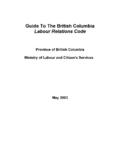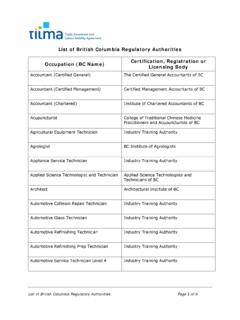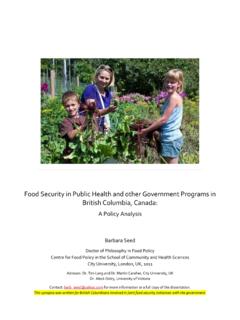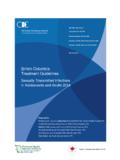Transcription of A REPORT AND ACTION PLAN TO ELIMINATE …
1 A REPORT AND ACTION PLAN TO. ELIMINATE DEATHS AND serious . injuries IN british columbia 'S. FORESTS. Final REPORT of the Forest Safety Task Force January 19, 2004. ACKNOWLEDGEMENTS. The Task Force acknowledges the support provided by its Secretariat: Tanner Elton, Tanner Elton & Associates Sheryl Wynne, Director, Governance, Workers' Compensation Board of BC. The Task Force acknowledges the advice and support provided by its Advisors: Roberta Ellis, Vice-President, Prevention Division, Workers' Compensation Board of BC. Roger Harris, MLA, Skeena John Mann, Vice-President, TimberWest Forest Corporation Ian May, Ian May Consulting Ltd. Keith Rush, General Manager, South Coast Operations, Interfor Don Wright, Chief Trade Negotiator, Ministry of Forests The Task Force also acknowledges the participation and assistance of its alternates: Jim Williams, Vice President, Canfor Corporation Jim Chorney, General Manager, Forest Industry Safety Association Al Dewar, Director, Health and Safety, Weyerhaeuser Wilf MacIntyre, National Vice-President, Industrial Wood and Allied Workers Union Don Mackay, Health and Safety Network Leader, Weyerhaeuser Finally, the Task Force wishes to thank all those who have provided input and participated in the process.
2 This REPORT is dedicated to all the forestry workers who have died or been seriously injured on the job in british columbia and to their families, friends and colleagues FOREST SAFETY TASK FORCE. A Task Force of Forest Industry Leaders appointed to develop an ACTION plan to ELIMINATE deaths and serious injuries in the BC Forest Industry January 19, 2004. The Honourable Graham Bruce Minister of Skills Development and Labour Province of british columbia Room 310 Parliament Buildings Victoria, british columbia V8V 1X4. Minister: It is my sincere pleasure to provide you with the final REPORT of the Forest Safety Task Force entitled A REPORT and ACTION Plan to ELIMINATE Deaths and serious injuries in british columbia 's Forests.. The Task Force was established in July 2003 to develop an ACTION plan to reduce the number of deaths and serious injuries in the forest industry in british columbia by 50 percent within three years. After its initial deliberations, the Task Force agreed that in order to be successful, a more aggressive target was required.
3 The attached REPORT covers all of the issues raised in the Terms of Reference and provides an ACTION plan for eliminating deaths and serious injuries in the sector. Thank you for creating the opportunity for the industry to come together to address the important issue of safety in the woods. Yours truly, Douglas J. Enns, FCA. Forest Safety Task Force Chair TASK FORCE MEMBERSHIP. Douglas Enns, Chair Dave Brensrud Chair, Board of Directors Independent Contract Faller Workers' Compensation Board of BC. Ron Corbeil Wayne Coulson National Health and Safety Director President and CEO. IWA Canada Coulson Forest Products Ltd. David Emerson Jim Girvan President and CEO Executive Director Canfor Corporation Truck Loggers' Association Dave Haggard Reid Hedlund President Chair, Forest Industry Safety Association IWA Canada Sandy McDade Keith Playfair President Director, KDL Group of Companies Weyerhaeuser Company Ltd. (Independent Contract Faller).
4 Jim Shepherd Les Veale President and CEO Chair, National Health and Safety Council Slocan Forest Products Ltd. IWA Canada TABLE OF CONTENTS. EXECUTIVE Background ..ii Key Drivers of injuries and Deaths .. iv Structure of Concluding THE ACTION PLAN ..1. CHAPTER STATEMENT OF PURPOSE ..17. Purpose ..17. Why the Task Force was Established ..17. What is to be Accomplished? ..19. How Did the Task Force Approach its Task? ..19. CHAPTER - OVERVIEW OF THE BC FOREST Purpose ..21. What Does the Forest Sector Look Like? ..21. Relevant Statistics ..24. The Human Face of serious Injury and CHAPTER - WHAT DRIVES THE serious INJURY AND death RATES. IN BC's FORESTS? ..31. Purpose ..31. Cultural and Social Factors ..31. Human Factors ..31. Structural and Technological Regulatory Factors ..32. Economic Factors ..33. CHAPTER - IT'S TIME TO CHANGE ATTITUDES AND Purpose ..34. A Fragmented Safety Culture ..34. A Safety Disconnect ..34. Ownership and Responsibility.
5 35. Societal Change ..35. Learning from Others ..36. CHAPTER THE HUMAN DYNAMIC ..38. Purpose ..38. Human Characteristics ..38. Changing Demographics ..38. Conditioning and Pride and The Human Environment ..41. CHAPTER CHANGING STRUCTURES AND Purpose ..43. Overview of Structure ..43. The Growing Use of Contractors ..43. Implementing Training and Supervision ..44. The Impact of New CHAPTER - THE REGULATORY Purpose ..48. The Changing Regulatory Landscape ..48. Overlap and Underlap ..49. Current Legislative and Regulatory Requirements ..49. Refocused CHAPTER ECONOMIC UNCERTAINTY ..54. Purpose ..54. Impact of Increased Demands for Efficiency ..54. Improving Costs through Safety ..55. Approaches to Funding Safety APPENDIX A - TASK FORCE TERMS OF APPENDIX B CONSULTATION APPENDIX C ADDITIONAL FATALITY APPENDIX D OVERVIEW OF BC FALLER TRAINING STANDARD ..72. APPENDIX E 1926 COMMENTARY ON FALLING ..76. FOREST SAFETY TASK FORCE. EXECUTIVE SUMMARY.
6 Introduction This REPORT sets out the recommendations of the Forest Safety Task Force (the Task Force ) and an ACTION Plan that, if effectively implemented, will fundamentally change how health and safety is treated by the forest industry in british columbia (BC). In its deliberations, the Task Force considered the many reasons why forest workers continue to die and be seriously injured at a staggering rate in BC. The Task Force also considered why, on average, 25 workers continue to die each year despite many previous efforts to reduce the number of fatalities and serious injuries in the sector. The Task Force has concluded that focus cannot simply be placed on reducing the number of deaths and serious injuries in the sector. To succeed, fundamental attitudes and behaviours about safety must change. The industry must agree that all deaths and serious injuries are preventable and that unsafe conditions and behaviours are unacceptable.
7 Success also requires a dedicated and focused safety infrastructure to ensure that the forest industry has the means to promote skill, experience and competence through the certification of workers, the pre-qualification of firms, the timely gathering and dissemination of safety information, on-going research on best practices and the impact of emerging technologies and other trends on the health and safety of workers. Success requires that the forest industry treat the health and safety of workers and worksites as both a shared and individual responsibility and as an over-riding priority. Finally, the success of the recommended ACTION Plan requires rigorous and effective implementation. In the past, recommendations have been made, put into reports, set to stakeholders and the relevant agencies and ministries, without thought as to how to manage the complex change of attitudes, procedures, programs and infrastructure. For this reason, the Task Force is recommending that there be a dedicated implementation team to ensure that there be a continuous focus on the important changes that are required.
8 This team will be critical if the cultural change that is needed is to emerge. Executive Summary i FOREST SAFETY TASK FORCE. Therefore, the ACTION Plan is based on the following four key pillars: 1. Cultural Change ACTION #1 - The Development of a Sector-Wide Health and Safety Accord 2. Assured Capacity ACTION #2 - The Development of a Sector-Wide Health and Safety Infrastructure 3. Shared Responsibility ACTION #3 - Promotion and Implementation of Cascading Responsibilities 4. Rigorous Implementation ACTION #4 Creation of an Implementation Team The solutions being recommended by the Task Force are not new nor are they ground- breaking. The solutions were gleaned from best practices within the industry itself, from other sectors, such as oil and gas and mining and from other jurisdictions, such as the United States, New Zealand and Finland. In this way, the Task Force believes that its recommendations and ACTION Plan are achievable with support and commitment from within the sector.
9 Background The Forest Safety Task Force was established by the Honourable Graham Bruce, Minister of Skills Development and Labour ( Minister ) in July 2003 to target the unacceptably high rates of deaths and serious injuries in british columbia 's forest industry. The impetus for the Task Force was clear on average, 25 workers die every year in BC forests. Over the last 10 years, BC has lost 250 forest workers. Many more have sustained serious , often career ending injuries . Between August 1 and December 11, 2003 (the duration of time when the Task Force met) there were three reported deaths in the BC forest sector. The impact of deaths and serious injuries in the forest sector is devastating on families, friends and co-workers. This impact, however, is generally not felt beyond the worker's family or community. This is in stark contrast to the impact that is felt throughout the Province when a police officer or firefighter dies in the line of duty or a window cleaner falls Executive Summary ii FOREST SAFETY TASK FORCE.
10 To their death in downtown Vancouver. Deaths and serious injuries in the forest sector have become socially acceptable; this must change. The mandate of the Task Force was to develop an ACTION Plan to reduce the number of deaths and serious injuries in the industry by half over the next three years, with further reductions in later years, and to REPORT back to the Minister. The Task Force was asked to use the 2002 Industrial Wood and Allied Workers of Canada (IWA) REPORT Coastal Logging Occupational Health and Safety as a starting point for its work. The IWA REPORT made 29. recommendations for improving health and safety in the coastal logging sector. In its initial deliberations, the Task Force decided that in order to be successful it would need to set an aggressive target. The Task Force thereby agreed to develop an ACTION Plan to ELIMINATE deaths and serious injuries in the industry and do so as soon as possible. The Task Force also determined early on that a successful ACTION Plan would require the commitment and engagement of all key forest industry stakeholders in all regions of the Province including fallers, truck drivers, regional forest industry associations, forest companies, First Nations groups, and Government.










